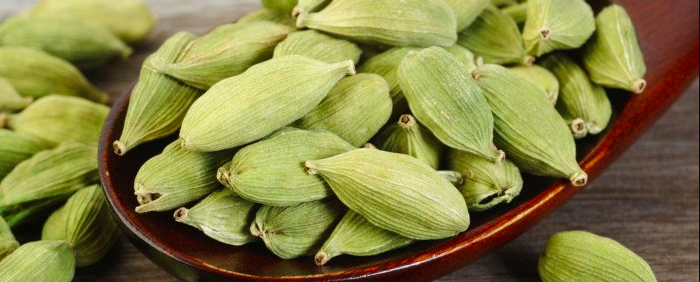
Cardamom is a spice found in Indian and Asian dishes. The scent of cardamom is very strong, so use it sparingly. We find lemon and peppery flavors (but not spicy) and a taste of pine sap. In the aftertaste, we can also find a slight menthol flavor.
Characteristics of cardamom:
- Helps digestion;
- Antiseptic;
- Source of calcium and magnesium;
- Source of vitamin B2 and B6;
- Fight against bad breath.
What is cardamom?
Cardamom identity card
- Type: Spice;
- Family: Zingiberaceae;
- Origin: Southeast Asia;
- Green color ;
- Flavor: Lemon and peppery.
Characteristics of cardamom
It is the dried fruit of the plant which is reduced to powder to obtain the spice which is used in cooking. It comes in the form of a green capsule containing dark brown grains which give the aroma to the spice.
One can also use cardamom in the form of essential oil in the form of massages diluted in a neutral oil.
Differences with nearby foods
Cardamom is from the same family as pepper, but unlike the latter, it is not spicy.
Word from the nutritionist
To benefit from the benefits of cardamom, simply flavor the dishes by combining it with turmeric and ginger in particular.
Nutritional values
For 100g of cardamom:
| Water | 8.28 g |
| Carbohydrates | 40.5 g |
| Fat | 6.7g |
| Protein | 10.8g |
| Calcium | 383 mg |
| Magnesium | 229 mg |
| Iron | 14 mg |
| Zinc | 7.47 mg |
| Vitamin B2 | 0.18 mg |
| Vitamin B6 | 0.23 mg |
| Energy | 321 kcal |
| Energy | 1340 kJ |
11 benefits of cardamom: why eat it?
- There has been a very beneficial effect on the digestive tract. Consumed in the form of herbal teas, cardamom reduces bloating and flatulence and is also a very good antispasmodic.
- Cardamom has been used to treat infections of teeth and gums in South Asia for hundreds of years, it is its vitamin B2 content which gives it its analgesic properties.
- In case of heartburn after meals, cardamom will allow you to calm the acid reflux, especially if you sprinkle your dishes with cardamom or consume fragrant infusions.
- Very stimulating for brain functions, cardamom also has aphrodisiac properties.
- To neutralize strong odors like that of garlic, all you have to do is chew on cardamom seeds at the end of a meal.
- Calcium is found in considerable quantities in cardamom, it facilitates blood clotting, regulates the nervous system and heart rate. Calcium plays a major role in building and maintaining good bone and dental health.
- The presence of magnesium in cardamom helps the proper functioning of muscles, nerves and intestines, it also reduces muscle aches and cramps.
- It contributes to the transport of oxygen in the body and also to the maintenance of a good enzymatic activity (including at the digestive level).
- Zinc contributes to the proper functioning of the pancreas, and to the renewal of cells by effectively fighting against free radicals.
- This vitamin will help stimulate appetite and brain functions, it also has an interesting analgesic action.
- Vitamin B6 is found in good quantity in cardamom, it will help absorb magnesium and the synthesis of keratin to maintain beautiful skin.
Choosing the right cardamom
Cardamom can be bought in seeds or already reduced to powder, it can be green or white depending on the origin of the plant.
Keep well
Like other spices, cardamom can be stored away from heat, light and moisture in an airtight container.
Cardamom preparation
How to cook it? How to match it?
Cardamom is found in recipes of Indian and Asian cuisine, but also in gingerbread, in Turkish coffee or Indian tea (chai massala). Cardamom is easy to consume in herbal teas, and enhances the taste of fruits, vegetables and white meats. On meats, it goes very well with turmeric, ginger and lime.
It can be used in baking and to enhance the flavor of jams or compotes. It also flavored fruit and chocolate recipes such as cakes or chocolate mousse.
Contraindication
Care should be taken to consume too much cardamom in people with severe heart or liver problems.
History of cardamom
Cardamom is a wild plant that has been domesticated in India.
The first uses of cardamom in Europe date back to the Middle Ages when it was used in the composition of a drink served as an aperitif.